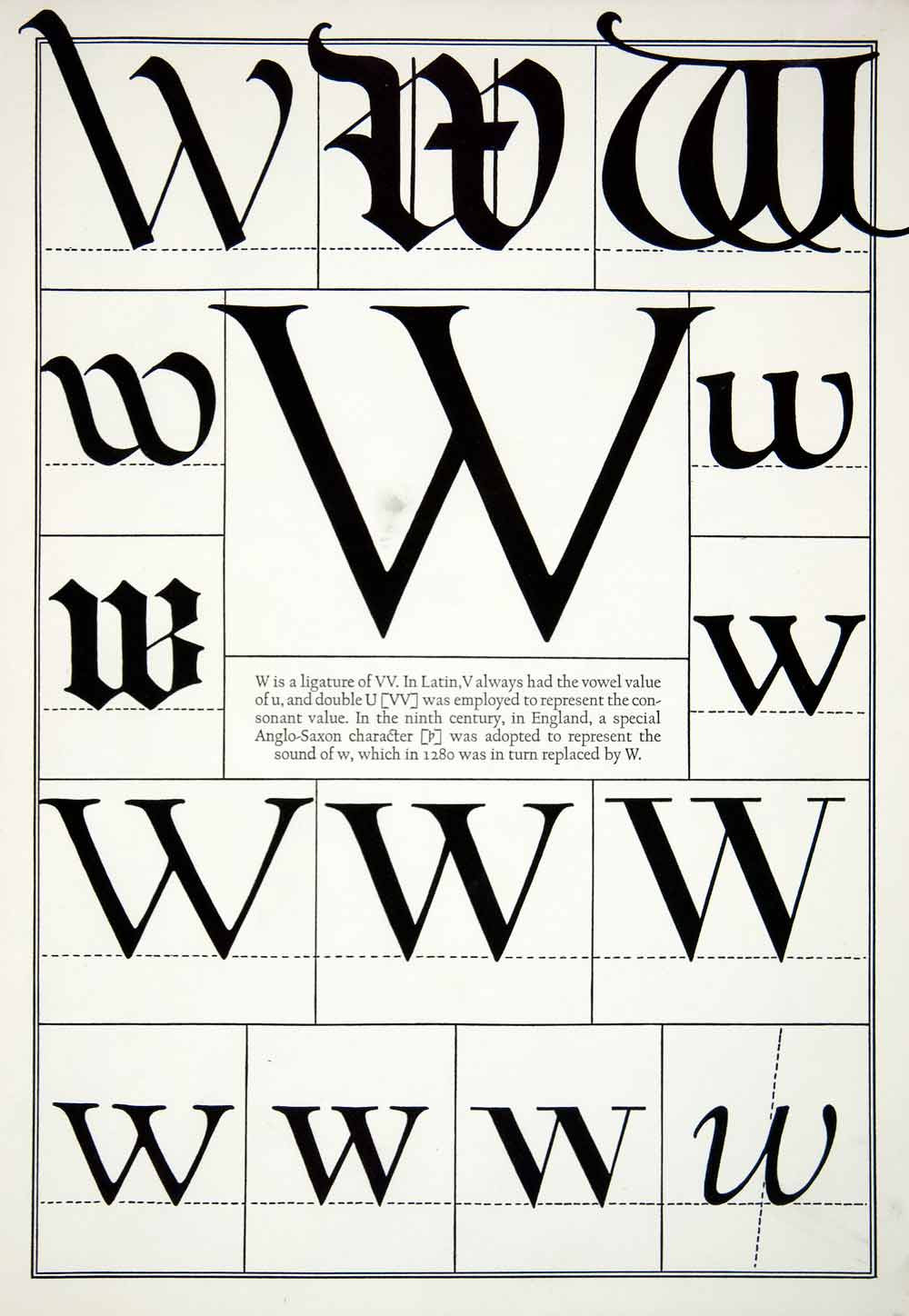PORTUGUÊS | ENGLISH | FRANÇAIS
GC6BTWJ
W

Impressão da Letra "W"
Goudy, Frederic W., 1942
Fonte: periodpaper.com
“W” é a vigésima terceira letra do alfabeto Latino.
Ao contrário do que se pensa, na sua origem não está a letra “v”, mas sim a letra “u”.
Para pronunciar o som /w/, os antigos Latinos não tinha nenhuma letra. Então começaram a utilizar “uu” para essa finalidade.
Com o fim do Império Romano do Ocidente no Século V, e da consequentemente perda de importância do Latim, os povos Anglo-Saxónicos passaram a usar a runa ᚹ(wynn) em vez de “uu”. No entanto, os povos Escandinavos continuaram a utilizá-lo.
Quando os Viquingues invadiram a Normandia (norte de França), no século VIII, trouxeram a representação “uu”, que acabou por substituir o “g” em algumas palavras francesas. Foi assim que Guillaume I se tornou UUilliam I.
Após a Conquista Normanda da Inglaterra em 1066, liderada pelo duque Guilherme I, “uu” passou a ser utilizado nesse território, em substituição da runa ᚹ(wynn).
Com a invenção da imprensa, “uu” caiu em desuso, passando a ser representado como “vv”, sendo posteriormente simplificado através da representação “w”.
No final do século XX, o “w” torna-se extremamente popular devido à World Wide Web. WWW tornou-se um dos acrónimos mais pronunciados no mundo.
Por favor note:
- Não publique textos ou fotografias que possam identificar a geocache ou a sua localização.
- Tenha cuidado com o manuseamento da geocache.
- Seja discreto e tenha cuidado com a eventual presença/passagem de muggles.
- Leve material de escrita.
GC6BTWJ
W

Print of the Letter “W”
Goudy, Frederic W., 1942
Font: periodpaper.com
"W" is the twenty-third letter of the Latin alphabet.
Contrary to popular belief, its origin is not the letter "v", but the letter "u".
To pronounce the sound /w/, the ancient Romans had no letter. Then they started using "uu" for this purpose.
With the end of the Western Roman Empire in the fifth century, and the consequently loss of importance of Latin, Anglo-Saxon people began to use the rune ᚹ (wynn) instead of "uu". However, the Scandinavian people continued to use it.
When the Vikings invaded Normandy (north of France), in the eighth century, they brought the representation "uu", which eventually replaced the "g" in some French words. That was how Guillaume I became UUilliam I.
After the Norman Conquest of England in 1066, led by Duke William I, "uu" started to be used in that territory, replacing the rune ᚹ (wynn).
With the invention of the press, "uu" fell into disuse, becoming represented as "vv", and later simplified by representing "w".
In the late twentieth century, the "w" becomes extremely popular because of the World Wide Web. WWW has become one of the most pronounced acronyms in the world.
Please note:
- Do not post text or pictures that can identify the geocache or its location.
- Be careful when handling the geocache.
- Be discreet and watch out for the possible presence/passage of muggles.
- Bring writing material.
GC6BTWJ
W

Impression de la Lettre “W”
Goudy, Frederic W., 1942
Font: periodpaper.com
"W" est la vingt-troisième lettre de l’alphabet latin.
Contrairement à la croyance populaire, son origine n’est pas la lettre “v”, mais la lettre "u".
Pour prononcer le son /w/, les anciens Latins n’avaient aucune lettre. Donc ils ont commencé à utiliser "uu" pour cette fin.
Avec la fin de l'Empire Romain d'Occident au Ve siècle, et par conséquent la perte d'importance du Latin, les gens Anglo-Saxons ont commencé à utiliser la rune ᚹ (wynn) au lieu de "uu". Cependant, les peuples Scandinaves ont continué à l'utiliser.
Lorsque les Vikings ont envahi la Normandie (nord de la France), au VIIIe siècle, ils ont apporté la représentation "uu", qui éventuellement a remplacé le “g” dans certains mots français. C’est comment Guillaume I est devenu UUilliam I.
Après la Conquête Normande de l'Angleterre en 1066, dirigée par le duc Guillaume I, "uu" a commencé à être utilisé dans ce territoire, en remplacement de la rune ᚹ (wynn).
Avec l'invention de la presse, "uu" est tombé en désuétude, devenant représenté comme "vv", et plus tard simplifié en représentant "w".
À la fin du XXe siècle, le "w" devient extrêmement populaire en raison de la World Wide Web. WWW est devenu l'un des acronymes les plus prononcés dans le monde.
Notez s’il vous plait:
- Ne postez pas des textes ou des images qui peuvent identifier la geocache ou sa localisation.
- Soyez prudent lorsque vous manipulez la geocache.
- Soyez discret et faites attention à la possible présence/passage de muggles.
- Apportez matériel d’écriture.
.
.
.